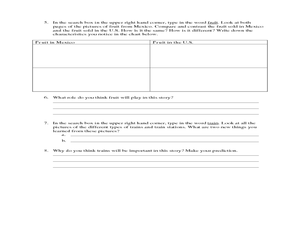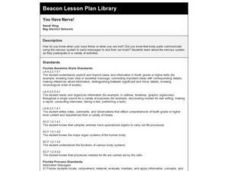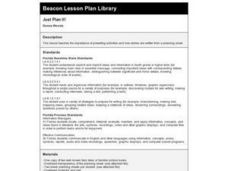Facing History and Ourselves
Confirmation and Other Biases
As the investigation into the reporting of the events in Ferguson, Missouri, continues, class members consider how bias influences perception, how the tendency is to collect evidence that supports preconceived notions. The big idea...
Curated OER
Esperanza Rising - Anticipation Guide
Learn about Mexican culture while simultaneously strengthening reading, writing and computer skills. In order to get the most out of Esperanza Rising, pupils should have prior knowledge of Mexican culture. Therefore, there are links to a...
National Endowment for the Humanities
Cultural Change
High schoolers research the passage of the 19th Amendment as an illustration of the mutual influence between political ideas and cultural attitudes. They also read the Seneca Falls Declaration and explore the cultural shifts it both...
Curated OER
Math Handbook: Calculus
If only there was a reference that listed all the formulas covered in calculus. Luckily, there is. This comprehensive 197-page handbook provides formulas and explanations for all topics in AP Calculus or in a standard college calculus...
Facing History and Ourselves
The Nazis in Power: Propaganda and Conformity
The Nazis used the power of propaganda to encourage confirmative views and the discrimination of Jews. A social studies resource illustrates these issues through discussion, image analysis, and a writing exercise.
Curated OER
Leveled Vocabulary for And Then There Were None
Chaotic, perjury, tenacious, vague, predatory, idiosyncrasy. Using Marzano and Brown’s six steps of direct instruction for vocabulary (choose, restate, illustrate, use, discuss, play) readers of And Then There Were None engage in a...
EngageNY
Using Sample Data to Compare the Means of Two or More Populations II
The 23rd segment in a series of 25 presents random samples from two populations to determine whether there is a difference. Groups determine whether they believe there is a difference between the two populations and later use an...
Curated OER
The Skeleton Within
Fourth graders explore the bones, joints, and other attributes of the skeletal system.
Curated OER
What a Waste!
Fourth graders explore the kidney, bladder, and function of the excretory (urinary) system.
Curated OER
You Have Nerve!
Fourth graders investigate the nervous system and how it communicates messages to and from the brain.
Curated OER
Bioethics
Students are introduced to the issues surrounding bioethics and begin to discover how some of these values can influence decision making. The exciting part of this lesson is the constructivist method used to engage students of all...
Curated OER
Women Writers and Dissent in 20th and 21st Century American Literature
Tenth graders read examples of writings by women authors showing their dissent. After completion of their reading, they brainstorm on why they believe female authors have criticized society. In groups, they use the Internet to research...
National Endowment for the Humanities
Common Sense: The Rhetoric of Popular Democracy
High schoolers identify important arguments for independence made in Thomas Paine's Common Sense. They explain why these arguments helped persuade American colonists that independence was necessary. Students describe the importance of...
Curated OER
The Life and Times of Robert Frost
Students explore the life and times of Robert Frost. Using a fact worksheet imbedded students access websites to gather information about the life and writings of Robert Frost.
Curated OER
I Need Air
Learners examine and research the organs of the respiratory system. They participate in a vocabulary card matching game, create a graphic organizer, and participate in an experiment titled, Floating on Air.
Curated OER
A Taste of Blackberries
Fourth graders participate in a shared reading of Doris Buchanan's, A Taste of Blackberries. They read about grief in the loss of a best friend and examine the skills of a responsible family member.
Curated OER
Cultural Exploration In The Magazine
Students discuss how various cultures spend their work and leisure time through identifying activities in magazine photographs. With proper grammar and usage, they list the activities noted in the photos and describe their cultural...
Curated OER
The Making of an Organ
Students examine and research how cells make up our organs. They create a model of a tongue showing cells, tissues and the organ.
Curated OER
Just Plan It!
Fourth graders practice using a planning sheet for a well-known fairy tale or picture book.
Curated OER
Too Many Tamales
Students investigate Mexican holiday celebrations and compare them to American Christmas holidays. They conduct a Mexican Christmas Scavenger Hunt. The lesson uses a streaming video in order to engage students in the main objectives.
Curated OER
Ray Frank on Gratitude and Repentance
Young scholars explore Ray Frank's biography and achievements in relation to expressing gratitude and repentance. They create a list of the things they are grateful for and what repentance means to them. After listening to a Talmudic...
Curated OER
A Journey to Paradigm Shifts Guided Through the Lives of Gandhi and King
The students read "The 7 Habits of Highly Effective Teens. Through this study the students will learn what paradigms are, and how to distinguish whether the paradigms they have established in their lives are positive or...
Curated OER
Composition of Functions
Students solve problems using the composition of functions. For this algebra lesson, students analyze the graph of a quadratic equation for its vertex and intercepts. they find the inverse of the function using addition, subtraction,...























